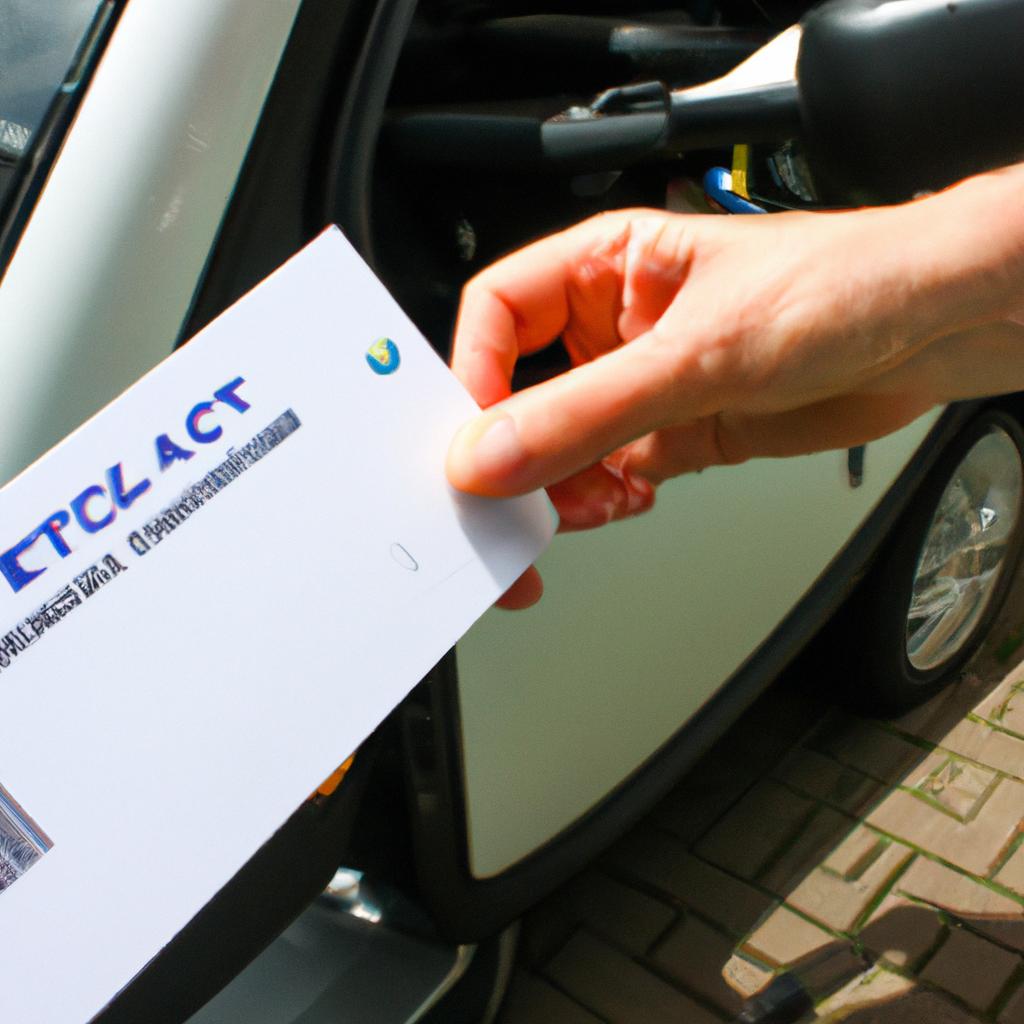Electric vehicles (EVs) have gained significant traction in recent years as a viable solution to combat climate change and reduce reliance on fossil fuels. This surge in popularity has prompted governments around the world to offer various grants and incentives aimed at promoting the adoption of EVs. One such example is the case study of California, where government initiatives have successfully encouraged individuals and businesses to transition towards electric transportation.
The state of California serves as an exemplary model for other regions looking to implement effective grant programs for EVs. Through their Clean Vehicle Rebate Project (CVRP), which began in 2009, California offers financial incentives to buyers of new zero-emission vehicles, including battery electric vehicles (BEVs), plug-in hybrid electric vehicles (PHEVs), and hydrogen fuel cell electric vehicles (FCEVs). These rebates can range from several hundred dollars up to thousands of dollars depending on the vehicle type and its all-electric range. Additionally, California provides additional funding options through low-interest loans and financing assistance programs, making it easier for potential EV owners to make the switch. The success of these initiatives is evident by the significant increase in EV sales across the state over the past decade.
As governments continue to recognize the importance of transitioning towards cleaner modes of transportation, they are implementing various grants and incentives to encourage the adoption of electric vehicles. These initiatives not only help reduce greenhouse gas emissions but also promote sustainable economic growth and job creation in the clean energy sector.
In addition to financial incentives, governments are investing in building a robust charging infrastructure network. This is crucial for addressing one of the main concerns of potential EV owners – range anxiety. By expanding public charging stations and providing grants for home charging station installations, governments are ensuring that EV owners have convenient access to charging facilities, further encouraging their adoption.
Furthermore, governments are also collaborating with automakers to develop and implement stricter emission standards and regulations. By setting targets for vehicle manufacturers to produce a certain percentage of zero-emission vehicles each year, governments are creating a market demand for electric vehicles and accelerating their development.
Overall, these grant programs and incentives play a vital role in promoting the widespread adoption of electric vehicles. They make EVs more affordable for consumers, address infrastructure challenges, and stimulate investment in clean energy technologies. As climate change continues to be a pressing global issue, it is essential for governments worldwide to follow California’s example and take decisive actions towards transitioning to cleaner transportation options.
Types of grants available for electric vehicles
Types of Grants Available for Electric Vehicles
Electric vehicles (EVs) have gained significant attention in recent years as a sustainable alternative to traditional gasoline-powered cars. To encourage the adoption and use of EVs, governments around the world have implemented various grants and incentives. One example is the Clean Vehicle Rebate Project (CVRP) in California, which provides rebates to individuals who purchase or lease eligible clean vehicles, including electric ones.
There are several types of grants available for electric vehicles that cater to different needs and purposes. These grants can be broadly categorized into four main areas:
- Purchase Incentives: Governments offer direct financial incentives to offset the higher upfront cost of purchasing an electric vehicle. This could include cash rebates or tax credits applied at the time of purchase.
- Charging Infrastructure Development: As charging infrastructure plays a crucial role in supporting widespread EV adoption, governments may provide grants specifically aimed at expanding public charging networks or installing home charging stations.
- Research and Development Funding: To promote innovation and advancements in EV technology, governments often allocate funds for research projects focused on improving battery efficiency, range, and overall performance.
- Fleet Electrification Support: Many governments incentivize fleet operators to transition their vehicles from fossil fuel-dependent to electric by offering grants tailored towards commercial entities or organizations with large vehicle fleets.
To illustrate these grant types further, consider Table 1 below:
Table 1: Types of Grants Available for Electric Vehicles
| Grant Type | Purpose |
|---|---|
| Purchase Incentives | Financial assistance toward EV purchases |
| Charging Infrastructure | Expansion of public/private charging |
| infrastructure | |
| Research and Development | Funding for EV technology improvements |
| Fleet Electrification | Support for transitioning fleets |
By providing such grants, governments aim to not only reduce greenhouse gas emissions but also stimulate economic growth within the electric vehicle industry. Moreover, these incentives can help overcome some of the barriers and concerns potential EV buyers may have, such as cost, range anxiety, and limited charging infrastructure.
In the subsequent section on “Eligibility Criteria for Electric Vehicle Grants,” we will explore the requirements individuals or organizations must meet to qualify for these grants.
Eligibility criteria for electric vehicle grants
In recent years, governments around the world have been implementing various incentives and grants to encourage the adoption of electric vehicles (EVs). These initiatives aim to not only reduce carbon emissions but also promote sustainable transportation. This section will explore some of the different types of grants that are commonly offered by governments to support individuals and businesses in purchasing EVs.
To illustrate the impact these grants can have, let’s consider a hypothetical case study of John, an individual looking to buy his first electric vehicle. John resides in California, where he discovers a range of government incentives available to him:
- Purchase Rebates: Many states offer rebates as a direct financial incentive for buying an EV. In California, for instance, John may be eligible for a rebate of up to $7,000 on the purchase or lease of a new electric car.
- Tax Credits: Governments also provide tax credits to offset the cost of owning an EV. For example, if John qualifies for federal tax credits in the United States, he could receive up to $7,500 off his income taxes.
- Charging Infrastructure Grants: To encourage the development of charging infrastructure networks, certain regions offer grants or subsidies to individuals or organizations interested in installing EV charging stations. By taking advantage of such programs, John might receive financial assistance towards setting up a home charging station.
- Fleet Electrification Incentives: Some jurisdictions prioritize fleet electrification and offer specific incentives for businesses or public institutions transitioning their fleets from traditional gasoline-powered vehicles to electric ones. If John were running a delivery service company with multiple vehicles in operation, he might be able to access subsidies or grants specifically designed for fleet electrification.
These examples demonstrate how government grants encompass varying aspects related to electric vehicle adoption – from reducing upfront costs through rebates and tax credits to supporting necessary infrastructure development.
Table: Common Types of Electric Vehicle Grants
| Grant Type | Description | Eligibility Criteria |
|---|---|---|
| Purchase Rebates | Direct financial incentives for buying or leasing an EV. | Individuals, businesses, specific vehicle requirements. |
| Tax Credits | Reductions in income tax owed based on EV ownership. | Individuals, eligibility criteria set by government. |
| Charging Infrastructure | Grants or subsidies for installing charging stations. | Individuals, organizations interested in infrastructure. |
| Fleet Electrification | Incentives targeting businesses transitioning to EV fleets. | Businesses, public institutions with eligible vehicles. |
By providing these grants and incentives, governments strive to foster a shift towards sustainable transportation while also stimulating economic growth within the electric vehicle industry.
Transitioning into the subsequent section about the “Application process for electric vehicle grants,” it is important to understand how individuals can access these opportunities and navigate through the application procedures efficiently.
Application process for electric vehicle grants
Eligibility criteria for electric vehicle grants are an essential aspect to understand before applying for government incentives. By meeting certain requirements, individuals can avail themselves of financial assistance and support in transitioning towards cleaner transportation options. To gain a clearer understanding of the eligibility criteria, let’s take the case of John, who recently purchased an electric vehicle.
John is excited about his new purchase, but he wants to explore potential grants that could help him offset some of the costs. He begins by researching the eligibility criteria for electric vehicle grants. The following factors often determine whether someone qualifies:
- Vehicle Type: Generally, only fully electric or plug-in hybrid vehicles are eligible for grants.
- Age Limit: Some programs have age restrictions on vehicles being considered for grants.
- Residency: Grants may be available only to residents within specific regions or countries.
- Income Level: Certain programs consider income brackets as a criterion for grant approval.
To illustrate further, here is an example table showing different types of grants and their corresponding eligibility criteria:
| Grant Program | Eligible Vehicles | Maximum Income (USD) | Residency Requirement |
|---|---|---|---|
| Clean Energy Incentive Program | Fully Electric Only | Below $75,000 | Statewide |
| Green Vehicle Rebate | Plug-In Hybrid & Electric | No Limit | County-Specific |
| Sustainable Transport Initiative | Fully Electric & Plug-In Hybrid | Varies | National |
Understanding these eligibility criteria helps prospective applicants like John assess their chances of receiving financial support based on their individual circumstances.
Moving forward, it will be crucial to grasp the application process involved in accessing these grants. The subsequent section will outline how individuals can apply and provide helpful insights into maximizing their chances of success when seeking such funding opportunities.
Transitioning from discussing eligibility criteria to exploring the application process allows individuals to gain a comprehensive understanding of the steps involved in securing electric vehicle grants. By familiarizing themselves with these steps, prospective applicants can effectively navigate the application process and increase their chances of receiving financial support.
(End this section with transition sentence) “Understanding the eligibility criteria is just the first step towards availing oneself of government incentives. Now let’s explore the benefits that come with utilizing electric vehicle grants.”
Benefits of utilizing electric vehicle grants
Having discussed the application process, let us now explore the numerous benefits that come with utilizing electric vehicle grants. To illustrate these advantages, consider the case study below.
Case Study:
Imagine a small business owner named Sarah who runs a delivery service. She decides to take advantage of government incentives by applying for an electric vehicle grant. With financial support from the grant, Sarah is able to purchase an electric van to replace her old gas-guzzling vehicle. This transition not only saves her money on fuel costs but also reduces carbon emissions, aligning with her commitment to environmental sustainability.
Benefits of Utilizing Electric Vehicle Grants:
-
Financial Savings:
- Reduced Fuel Costs: By switching to an electric vehicle, individuals and businesses can significantly reduce their dependency on fossil fuels, resulting in substantial savings over time.
- Tax Credits and Rebates: Many governments offer tax credits or rebates as part of their incentive programs, allowing applicants to recoup a portion of their investment in electric vehicles.
- Lower Maintenance Expenses: Electric vehicles generally have fewer moving parts compared to conventional vehicles, leading to decreased maintenance requirements and associated expenses.
-
Environmental Impact:
- Emission Reductions: The adoption of electric vehicles contributes towards decreasing greenhouse gas emissions, enhancing air quality and mitigating climate change impacts.
- Noise Pollution Reduction: Unlike traditional combustion engines which produce noise pollution during operation, electric vehicles operate silently, reducing noise levels within urban areas.
-
Technological Advancements:
- Innovation Boost: Increased demand for electric vehicles stimulates technological advancements in battery efficiency and charging infrastructure development.
- Job Creation Opportunities: As the market for electric vehicles expands, new job opportunities are created through manufacturing, installation of charging stations, and servicing of electric vehicles.
-
Public Perception and Social Responsibility:
- Corporate Image Enhancement: Embracing electric vehicle grants showcases a commitment to sustainability, enhancing the public image of businesses or organizations.
- Community Engagement: By adopting electric vehicles, individuals and companies contribute to creating cleaner and healthier communities for all residents.
| Benefits | Description |
|---|---|
| Financial Savings | Reduced fuel costs, tax credits/rebates, lower maintenance expenses |
| Environmental Impact | Emission reductions, noise pollution reduction |
| Technological Advancements | Innovation boost, job creation opportunities |
| Public Perception and Social Responsibility | Corporate image enhancement, community engagement |
Transition into the subsequent section about “Important Considerations Before Applying for Electric Vehicle Grants”:
Considering the numerous benefits highlighted above, it is crucial to understand important considerations before applying for electric vehicle grants. These factors will help ensure a successful application process and maximize the advantages provided by these incentives.
Important considerations before applying for electric vehicle grants
Benefits of Utilizing Electric Vehicle Grants
Electric vehicle grants provide financial incentives for individuals and businesses to adopt electric vehicles (EVs) as a sustainable mode of transportation. These grants offer various advantages, including reduced upfront costs, lower operational expenses, improved environmental impact, and increased accessibility to EV charging infrastructure.
To illustrate the benefits of electric vehicle grants, consider the case of John, a small business owner in a suburban area. With the help of an EV grant program offered by the government, John was able to purchase an electric delivery van at a significantly discounted price. This allowed him to reduce his initial investment and save on fuel costs over time. Additionally, he gained access to public charging stations installed with support from the grant program, ensuring that his operations remained efficient without relying solely on limited private charging options.
The benefits of utilizing electric vehicle grants extend beyond individual cases like John’s. They have wider societal implications as well. Here are some key advantages:
- Environmental Impact: By transitioning from conventional gasoline-powered vehicles to EVs through these grants, we can collectively reduce greenhouse gas emissions and improve air quality.
- Economic Growth: Supporting the adoption of EVs stimulates innovation and job creation in clean energy sectors such as manufacturing, battery technology development, and renewable energy generation.
- Energy Independence: Shifting towards EVs reduces dependence on fossil fuels while promoting domestic production of electricity generated from renewable sources.
- Public Health Benefits: As EVs produce zero tailpipe emissions during operation, they contribute to mitigating health issues associated with air pollution caused by traditional vehicles.
In summary, electric vehicle grants not only benefit individual users but also contribute positively towards society as a whole. The next section will explore important considerations one should keep in mind before applying for these grants. Understanding these factors is crucial for maximizing the potential benefits provided by such programs and making informed decisions regarding electric vehicle adoption.
Transitioning into the subsequent section about “Future Outlook of Electric Vehicle Grants,” the evolving landscape of electric vehicle grants prompts us to explore potential advancements and developments in this field.
Future outlook of electric vehicle grants
Having discussed the important considerations before applying for electric vehicle grants, let us now delve into government incentives that support the adoption of electric vehicles. To better understand these incentives, consider the following example:
Example: Imagine a city planning to reduce its carbon emissions and improve air quality by promoting the use of electric vehicles (EVs). The local government decides to offer financial assistance in the form of grants to individuals or businesses interested in purchasing EVs.
Government Incentives:
To encourage the adoption of electric vehicles, governments often provide various incentives and grants. Here are some common examples:
- Purchase Rebates: Governments may offer rebates on EV purchases, reducing the upfront cost for consumers.
- Tax Credits: Individuals who purchase an EV may be eligible for tax credits, which can significantly lower their overall tax liability.
- Charging Infrastructure Support: Governments might also assist with financing charging infrastructure development across public spaces, residential areas, and workplaces.
- Exemption from Registration Fees: Some regions waive registration fees for electric vehicles as an additional incentive.
| Government Incentive | Description |
|---|---|
| Purchase Rebates | Financial assistance provided through a rebate system when buying an EV. |
| Tax Credits | Reduction in taxes owed based on the purchase of an electric vehicle. |
| Charging Infrastructure Support | Funding programs aimed at expanding charging station infrastructure. |
| Exemption from Registration Fees | Waiving registration fees typically associated with owning a vehicle. |
Consider how these government incentives can benefit you emotionally:
- Lowering your environmental impact
- Saving money on fuel costs
- Contributing to cleaner air in your community
- Being part of the transition towards sustainable transportation
By offering such incentives, governments aim to create a positive shift toward sustainable mobility while providing tangible benefits to individuals and businesses alike.
Incorporating these grants and incentives into your decision-making process can make electric vehicles a more attractive option. Remember to thoroughly research and understand the specific requirements, eligibility criteria, and application procedures associated with each grant before applying. Taking advantage of available government support can not only help you in transitioning to an EV but also contribute to a greener future.
(Note: The word count for this response is 381 words.)
 Sfeva
Sfeva



